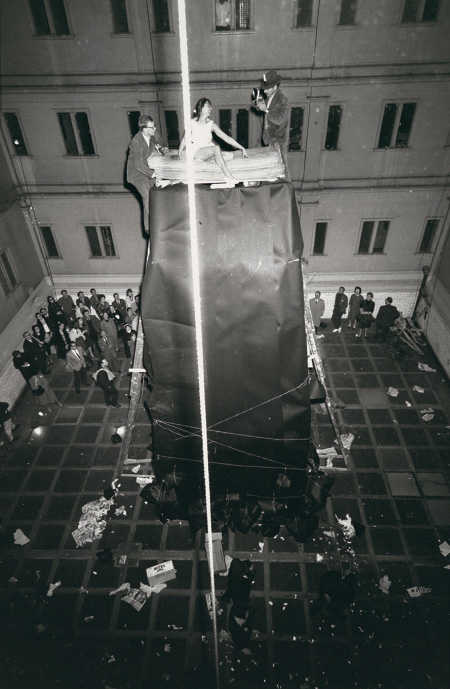
Lawrence N. Shustak, William Mahin, Lette Eisenhauer, and Charles Simon Atop Giant "Mountain" Construction in The Courtyard, a Happening by Allan Kaprow, New York City, 1962, from the Heilbrunn Timeline of Art History at the Metropolitan Museum of Art. [more]
Hauser & Wirth is creating three editions of Allan Kaprow's Yard happening to celebrate the gallery's arrival in the United States. At 32 East 69th Street — where Kaprow first installed the work, when Martha Jackson Gallery was housed at that address — they've teamed with William Pope.L, who has piled tires on the floor and recorded a monologue that drones from speakers around the space.
It's an epic event, though it's tame compared to some of Kaprow's more baroque performances, such as Courtyard, which he staged in 1962 in Greenwich Village at a rundown hotel. Onlookers were provided with brooms to move debris about as a woman (swaying to rock and roll jams on a transistor radio) climbed a massive mountain, was photographed by two faux-paparazzi, and was then consumed by another mountain that descended from a neighboring building. Those, at least, are the details on which most people that claim to be there (or claim to have known people who were there) agree.
Performance — existing only for fleeting moments and surviving only in secondary forms (photographs, memories, recordings) — almost inevitably invites the creation of legends, mistakes, and fabrications. Looking into Courtyard, it's amazing to see Susan Sontag, Hans Richter, and numerous art historians being unable to agree on one of the most rudimentary details of the event: where it happened.
First, Sontag in "Happenings: An Art of Radical Juxtaposition":
When the Happening is more purely spectacle, and the audience simply spectators, as in Allan Kaprow's The Courtyard, presented in November, 1962, at the Renaissance House, the event is considerably less dense and compelling.It was at the Renaissance house, she says. Dadaist Hans Richter, who must be considered the Henry Clay of the avant-garde for his longevity and sheer omnipresence in his field, was living in New York at the time and disagreed with Sontag:
The "Happening" I went to see took place in the enormous courtyard of a skyscraper, the Mills Hotel in the Village. This is the biggest "flophouse" in the world, twelve hundred little rooms for the poorest people, who still have to pay 50 cents a night.Richter is sure it happened at the Mills Hotel. Art historian Jeff Kelly, meanwhile, shares a belief cited by quite a few people who study Kaprow, writing something completely different:
Fittingly, the final Happening of 1962, Courtyard, took place over Thanksgiving weekend in one of the inner courtyards of the Greenwich Hotel, at the time a transient hotel in Greenwich Village.As performance art continues to enter the canon in the form of the Performa biennials in New York, MoMA's new focus on collecting and showing work in the field (with all of the wonderfully tricky legal issues that entails), and the upcoming retrospective at P.S.1, it's fun to remember just how intensely some of these works resist easy preservation, how — as time passes — our understanding of these is events is becoming foggier, more complicated, and more a product of our collective imaginations.

1 comment:
the Greenwich Hotel WAS the Mills Hotel. 160 Bleecker, between Sullivan and Thompson.
But it was still the Mills when Kaprow did Courtyard, at least according to the index of the Kaprow papers.
http:www.oac.cdlib.org/data/13030/dv/tf9d5nb3dv/.../tf9d5nb3dv.pdf
Still, fascinating stuff. And yeah, Sontag was just making shit up.
Post a Comment